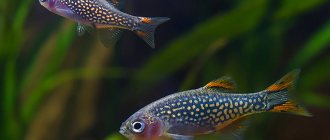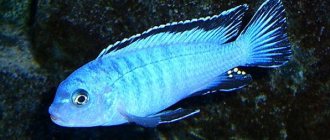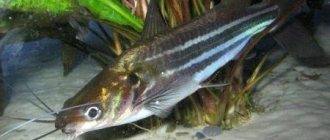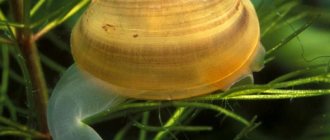Black baggrus (lat. Mystus leucophasis or Heterobagrus leucophasis), which is also called black killer whale, changeling killer whale, black mystus, is an interesting, but rarely found on sale catfish. Outwardly, it looks like a classic representative of a catfish - four pairs of whiskers reaching the length of almost half the body, a long dorsal fin, and a body shape typical of a predator.
Black bugrus
Black bagrus photo
Black bagrus, also known as black killer whale, black mystus (lat. Mystus leucophasis or Heterobagrus leucophasis) is a very interesting, but quite rare catfish on sale. The peculiarity of the black bargus is that, like synodontis, it likes to turn upside down with its belly, for which the British received the nickname Asian upside down catfish.
Externally, the black mystus is a striking representative of the catfish: four pairs of whiskers up to half the length of the body, a high dorsal fin, the body itself has a typical “predatory” shape. Black bagrus catfish in nature can grow up to 30 cm, in aquariums no more than 20 cm.
The body color is black; when viewed from a distance, up close you can see silvery spots running along the body. As the fish grows, the spots also increase, and over time it becomes as if powdered with flour.
In nature, the black bagus lives in Myanmar, in the largest river, the Irrawaddy River and its tributaries. A typical river catfish, active at night.
Contents of black bagus
Black mystus is a nocturnal resident, but as it gets used to living in your aquarium, it begins to show daytime activity. His active movements impose restrictions on the possibility of growing plants in an aquarium with a bagus; he will simply dig them up or break them.
It is also not suitable for common aquariums; neighbors need to be selected very carefully. The black bug is quite aggressive and is an active predator. Small and slow neighbors can become dinner, so you need to select commensurate fish that can fend for themselves as roommates. It can get along with fast and large fish, for example, the bream barb, large cichlids, even African mbuna. You can keep black killer whales either alone or in a flock; from time to time, fights and showdowns can occur in a catfish family, but, fortunately, this usually occurs without serious injuries. Several males of black mystus definitely will not get along in one aquarium; the optimal combination is a male and 2-3 females. Ideally, this is a fish for a species aquarium.
Black bugs are excellent jumpers, so it is better to cover the aquarium with them. Considering the non-compact size of adult catfish, an aquarium for keeping them needs to be chosen with a large volume of 400 liters or more. In the aquarium, it is necessary to provide not only comfortable water parameters, but also the presence of shelters (coconuts, pots, stones, pipes, driftwood), at least 1 piece per individual.
Black bagus photo
The black mystus spends a lot of time in an upside-down position and is therefore often confused with the ordinary catfish. But mysthuses differ in color (it’s not difficult to guess what), besides, they grow larger and are not very suitable for general aquariums.
Water parameters do not play a particularly important role, but the ideal ones would be: pH: 6.0-8.0, hardness 5-20°H, water temperature 23-27°. Like true river inhabitants, black bugs love strong currents.
Black bug is suitable only for experienced aquarists and is not recommended for beginners.
Feeding the black bug
Black bagus photo
Black bug is not picky; it can eat dry, frozen, and live food (including small neighbors in the aquarium).
Feeding any aquarium fish should be correct: balanced, varied. This fundamental rule is the key to the successful keeping of any fish, be it guppies or astronotuses. The article “How and how much to feed aquarium fish” talks about this in detail; it outlines the basic principles of the diet and feeding regime of the fish.
In this article, we note the most important thing - feeding fish should not be monotonous; the diet should include both dry food and live food. In addition, you need to take into account the gastronomic preferences of a particular fish and, depending on this, include in its diet food either with the highest protein content or, conversely, with plant ingredients.
Popular and popular food for fish, of course, is dry food. For example, you can constantly and everywhere find food from Tetra, the leader of the Russian market, on aquarium shelves; in fact, the range of food from this Tetra is included as individual food for a specific type of fish: for goldfish, for cichlids, for loricariids, guppies, labyrinths, arowanas, and discus fish. etc. Tetra has also developed specialized foods, for example, to enhance color, fortified, or for feeding fry. You can find out detailed information about all Tetra foods on the company's official website - here .
Description
This miniature fish reaches a length of no more than 3 cm. The catfish leads an active lifestyle, which affected its appearance.
The body is slender with well-developed fins necessary for fast swimming. The head is large with large eyes that help capture dim light in murky waters. Sensitive antennae located near the mouth also help for orientation and search. The body color is silvery, in places (in the abdomen) translucent. The pattern consists of a black stripe stretching along the entire body and dark specks.
Black killer whale or bargus
Black baggrus (lat. Mystus leucophasis or Heterobagrus leucophasis), which is also called black killer whale, changeling killer whale, black mystus, is an interesting, but rarely found on sale catfish.
Outwardly, it looks like a classic representative of a catfish - four pairs of whiskers reaching the length of almost half the body, a long dorsal fin, and a body shape typical of a predator.
The peculiarity of the black bargus is that, like synodontis, it often turns over and swims upside down, for which it received the name Asian upside down catfish in English.
Breeding
Mystus becomes sexually mature at the age of one year. For reproduction, 2-4 males are usually chosen per female, but pair spawning is also possible.
You need an aquarium with a volume of 100 liters or more. Water temperature is 26C, acidity is unchanged (6-7pH), and minimum hardness is 4dH. Moss, loofah or small-leaved plants are used as a subtract.
Breeders need to be fed a variety of high-protein foods. After the female has collected eggs, special injections should be given (bream pituitary gland mixed with a hormonal drug). Unfortunately, no evidence of reproduction in captivity without stimulants has been recorded.
After this, you will need to change the water (if it is cloudy from milk) and, possibly, special expressing of the female’s eggs. The eggs take approximately 30 hours to develop. Ciliates are used as the first food; after a couple of days, Artemia nauplii can be introduced into the diet.
Large fry can eat small ones, so calibration is necessary. Babies grow quickly and at the age of three months the sex of the catfish can be determined.
Keeping in an aquarium
At first it is active only at night, but as it adapts, it begins to swim during the day. Since the black bargus is a very active swimmer, it is not suitable for an aquarium with a large number of plants, as they will be broken and dug up.
It is also not suitable for common aquariums; neighbors need to be selected very carefully. Ideally, this is a fish for species-specific keeping, separately in an aquarium.
The shapeshifting killer whale is only suitable for experienced aquarists and is not recommended for beginners.
Water parameters are not too important, but ideal would be: water temperature 23-27°C, pH: 6.0-8.0, hardness 5-20°H. They love strong currents, like all river inhabitants.
They jump well, so the aquarium needs to be covered. Considering the rather large size of adult catfish, it is advisable to keep an aquarium of at least 400 liters
Decor for keeping is not of great importance, but it is important that the aquarium has at least one shelter per individual. These could be driftwood, coconuts, pots, or plastic and ceramic pipes.
They spend a lot of time in an upside-down position, so when buying them they are often confused with the catfish. However, black bugrus is a different color (it’s easy to guess which one), larger, and most importantly, much less suitable for general aquariums.
Reproduction
First of all, they choose young, strong individuals. By placing the breeders in a separate container (volume - 30-70 l), gradually lowering the water temperature in the aquarium to 18-20°, you can stimulate the reproduction of bottom inhabitants. The spawning ground is equipped with an aerator, plants are planted, and the bottom is covered with leaves.
Aquarium 70 liters
Shelters are placed at the bottom: driftwood, hollow tubes, grottoes. The lighting needs to be dimmed. The fish begin to be fed abundantly. It is very interesting to watch how these amazing catfish reproduce!
The gentleman will court the lady for a week. He spins around, shows off his outfit and shows sympathy in every possible way, touching her with his mustache. The chosen one invites the interested female to look into a secluded corner of the fish paradise.
During one spawning, which lasts 3-4 hours, mother catfish lays up to 200 very large eggs. The balls stuck together resemble a bunch of grapes.
After the end of spawning, the parents are sent to their previous home. The temperature in the fish incubator needs to be increased to 27-28°C. Here, the future fry mature in 5-6 days. The hatched babies look like eggs with a tail, because they have a yolk sac attached to them, which supplies the fry with food. Over the next week, swaying in place, the children grow up. Having started to swim, the fry switches to crushed live food, eating it 3-4 times a day. Within a month, the child’s height increases to 1 cm.
Compatibility
They can be territorial and aggressive, depending on the nature of the individual. He eats small fish with pleasure, and bothers slow and leisurely neighbors, constantly feeling them with his whiskers (to see if the object will fit into his mouth or not).
However, it can get along with fast and large fish, for example, with the bream barb, large cichlids, even with African mbuna (as long as the size of the fish does not allow it to be swallowed).
Usually they cannot tolerate their relatives; it is better to keep one black mystus or several in an aquarium, but in a very spacious one.
Proper feeding of the rainbow crab
Feeding the rainbow crab
Crabs are, at their core, scavengers. Crustaceans generally lack the hunting instinct. The diet should be varied, it should include both protein and plant foods. Every day, the crab should eat pieces of beef or chicken liver, mussels, shrimp or frozen bloodworm. The percentage of vegetation consumed should prevail. It could be pumpkin, cabbage, carrots, spinach, lettuce, greens. Among fruits, the crab likes to eat apples, bananas, and pears. All food should be either finely chopped or grated. Adequate nutrition will have a positive effect on the health of the crab, and will also contribute to rapid recovery during molting.
Changeling catfish: habitat
Representatives of the species Synodontis nigriventris belong to the order Siluriformes, family Mochokidae (fringed cyprinids). This cute fish comes from tropical Africa. At home, it lives in densely overgrown areas of Cameroon and Congo. It is most often found in tributaries of the Lekini and Congo rivers, in lakes with clear and clean water. In Europe, the aquarium catfish (you can see the photo in this article) appeared in 1950.
Behavior
We have already said that the catfish is most active at night. Daylight is unpleasant for him, so he hides from it in artificial shelters. Despite his quite peaceful disposition, the changeling can stand up for himself. It easily gets along with its more aggressive neighbors - cyclids. And it is better not to add smaller species of fish (neons, guppies) to catfish, since synodontis hunts at night and can attack its neighbors. Changelings are kept in small flocks (5-7 individuals). If you are going to get catfish, but you already have smaller fish, then speckled catfish or “suckers” are more suitable for you - they certainly won’t offend anyone.
Dimensions
Catfish is the largest in size and weight among our freshwater fish. Catfish can reach truly enormous sizes; it’s not for nothing that there are so many legends about monster catfish.
According to historical data that has reached us, in the past in European rivers: the Dnieper, Dniester and Oder, giant catfish were caught, reaching a weight of up to 400 kg, with a body length of up to 5 meters. These data can be trusted, since the largest officially registered caught catfish weighed 306 kg, with a body length of more than 3 meters and was about 80 years old.
These days, catfish weighing more than 100 kg are very rare. Catfish weighing 100 kg can be caught in Spain, in the Ebro River, where they were acclimatized in the mid-20th century and quickly multiplied. In the Volga you can find catfish with a body weight of about 50 kg.
Fishermen consider a catfish weighing between 12-15 kg to be a good trophy, and a caught catfish heavier than 30 kg is considered a great once-in-a-lifetime opportunity.











